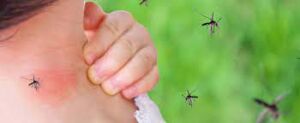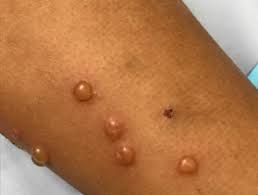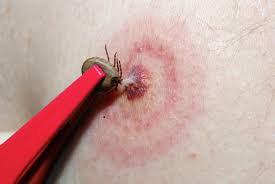What to Do for Insect Bites and Stings: Symptoms, Treatment, and When to Seek Help
puncture or penetration of the skin by an insect’s mouthparts or stinger. Bites and stings are a common occurrence in nature, with many different kinds of animals capable of inflicting a painful experience. Insects such as wasps and bees have stingers that can inject venom into the skin, while spiders, snakes, and scorpions may also bite their victims. Bites from ticks and mosquitoes can cause infections or other diseases, while jellyfish stings may result in severe allergic reactions and even death. In addition to physical discomfort, bites and stings can cause psychological distress due to the fear of paralysis or other serious health effects. Fortunately, there are numerous treatments available for both bites and stings that can reduce pain, inflammation, and the risk of infection. Please keep reading for details on the following topics:
Types of insects
Signs and symptoms of an insect bite or sting
How to manage bites
Signs and symptoms of spider mark
Ticks
How to avoid getting stung
How to relieve an itch

Types of insects

Various types of insects can bite or sting humans, each with its own characteristics and potential effects. Here are some common types:
- Mosquitoes: These blood-feeding insects can leave itchy welts on the skin and may transmit diseases such as malaria, dengue fever, and Zika virus.
- Ticks can attach to the skin and feed on blood, potentially transmitting diseases such as Lyme disease and Rocky Mountain spotted fever.
- Bees can sting humans in defense, leaving behind a venomous stinger. Some individuals may experience severe allergic reactions to bee stings.
- Ants: Certain species of ants, such as fire ants, can deliver painful stings that may cause localized swelling and itching.
- Wasps and Hornets: These insects have venomous stingers and can deliver painful stings, which may cause swelling, redness, and itching.
- Spiders: While most spiders are not harmful to humans, bites from venomous spiders like black widows and brown recluses can cause severe reactions, including muscle spasms, nausea, and tissue necrosis.
-
Centipedes have venomous claws that they use to capture prey, and their bites can cause localized pain and swelling in humans.
Signs and symptoms of an insect bite or sting

These can vary depending on the type of insect involved and the individual’s reaction to it and may include:
- Pain or discomfort at the site of the bite or sting.
- Itching or irritation in the affected area.
- Redness or inflammation around the bite or sting site.
- Swelling, which may be localized or spread to surrounding areas.
- Formation of hives or a rash, especially in individuals with allergic reactions.
- Formation of a small puncture mark or entry point at the site of the bite.
- Bleeding or oozing of fluid from the bite site.
- Formation of a wheal or blister.
- Numbness or tingling sensation in the affected area.
- Systemic reactions such as nausea, vomiting, dizziness, or difficulty breathing, which may indicate a severe allergic reaction (anaphylaxis).
- Discoloration of the skin around the bite or sting area, such as redness or bruising.
- Formation of small bumps or raised areas on the skin.
- Presence of a black spot at the site of the sting, indicating the stinger has been left behind (typically seen with bee stings).
How to manage bites
Managing insect bites involves several steps to alleviate discomfort and reduce the risk of complications. Here’s how to manage insect bites effectively:
- If you have a history of severe allergic reactions to insect stings or if symptoms persist or worsen, seek medical attention promptly.
- Wash the area: Clean the bite or sting site with mild soap and water to remove any dirt, bacteria, or venom. Gently pat the area dry with a clean towel.
- Avoid scratching: Although it may be tempting, scratching the bite can lead to further irritation, inflammation, and even infection. Try to resist the urge to scratch and instead focus on other methods for relieving itching.
- Apply a cold compress: Use a cold compress or ice pack wrapped in a cloth to help reduce swelling, numb the area, and alleviate pain. Apply the cold compress to the bite for 10-15 minutes at a time, several times a day.
- Use topical treatments: Over-the-counter anti-itch creams or lotions containing ingredients like hydrocortisone, calamine, or menthol can help relieve itching and inflammation. Apply the topical treatment according to the manufacturer’s instructions.
- Take oral antihistamines: If itching is severe, oral antihistamine medications such as diphenhydramine (Benadryl) or loratadine (Claritin) can provide additional relief. Follow the dosage instructions on the package or consult a healthcare professional.
- Elevate the affected area: If possible, elevate the bitten or stung area to reduce swelling and promote circulation. For example, if the bite is on the leg or arm, prop it up on pillows while resting.
- Monitor for signs of infection: Keep an eye on the bite site for any signs of infection, such as increasing redness, warmth, swelling, or pus. If infection occurs, seek medical attention promptly.
- Seek medical help if needed: If you experience severe symptoms such as difficulty breathing, swelling of the face or throat, rapid heartbeat, or signs of anaphylaxis, seek immediate medical attention. Anaphylaxis is a medical emergency and requires prompt treatment with epinephrine.
For managing mosquito bites, here are specific steps to follow:
-
Wash the bite: Clean the mosquito bite with plenty of soap and water to remove any dirt or bacteria that could lead to infection. Gently pat the area dry with a clean towel afterward.
- Avoid scratching: Refrain from scratching the mosquito bite, as this can irritate the skin further and increase the risk of infection. If itching is severe, try using other methods to relieve the itch.
-
Use anti-itch medication: Over the counter or prescribed anti-itch medications such as hydrocortisone cream or oral antihistamines can help alleviate itching and inflammation. Follow the instructions provided by your healthcare provider or on the medication label.
Spider bites can vary in severity depending on the species of spider and individual reaction. Some spiders, such as black widow spiders and brown recluse spiders, are known to deliver venomous bites that can cause significant symptoms. Here’s how to identify and manage a spider bite:
- Black Widow Spider Bite:
- Black widow spiders are identifiable by their shiny black color and red hourglass-shaped mark on the underside of their abdomen.
- Symptoms of a black widow spider bite may include:
- Intense pain at the bite site
- Muscle cramps and spasms, particularly in the abdomen
- Nausea and vomiting
- Sweating
- Headache
- Fever
- If you suspect a black widow spider bite, seek immediate medical attention. Treatment may include antivenom and supportive care to manage symptoms.
- Brown Recluse Spider Bite:
- Brown recluse spiders are brown with a distinctive violin-shaped mark on their back.
- Symptoms of a brown recluse spider bite may include:
- Redness and swelling at the bite site
- Pain and itching
- Blistering and ulceration of the skin
- Fever
- Nausea and vomiting
- Brown recluse spider bites can cause tissue necrosis (death) in severe cases. If bitten, seek medical attention promptly for evaluation and treatment.
If you suspect you’ve been bitten by a venomous spider or if you develop severe symptoms, seek medical attention immediately. In the meantime, you can:
-
- Wash the bite site with soap and water to reduce the risk of infection.
- Apply a cold compress or ice pack wrapped in a cloth to reduce swelling and pain.
- Keep the affected limb elevated to minimize swelling.
- Avoid applying heat or tight bandages, as these can worsen symptoms.
- Take over-the-counter pain relievers if needed.
A healthcare professional can assess the severity of the spider bite and provide appropriate treatment, which may include:
-
- Administration of antivenom for certain spider species.
- Pain management with medications.
- Wound care and monitoring for signs of infection or tissue necrosis.
- Tetanus vaccination if necessary.
- Follow-up care to ensure proper healing and resolution of symptoms.
Ticks

How to avoid getting stung
To avoid getting stung by insects like bees, wasps, hornets, and other stinging insects, follow these preventive measures:
-
Wear protective clothing: When spending time outdoors, especially in areas known to have stinging insects, wear long-sleeved shirts, long pants, and closed-toe shoes. Light-colored clothing may also be less attractive to insects.
- Avoid strong fragrances: Perfumes, scented lotions, and hair products can attract stinging insects. Opt for unscented products when spending time outdoors.
- Be cautious around food and drinks: Stinging insects are attracted to sweet foods and beverages. Keep food and drinks covered when dining outdoors and promptly clean up spills to avoid attracting them.
- Keep outdoor areas clean: Dispose of garbage promptly and keep outdoor eating areas clean to reduce the likelihood of attracting stinging insects.
- Be mindful of flowering plants: Stinging insects are attracted to flowers, so be cautious when working in gardens or near flowering plants. Avoid sudden movements and wear protective clothing if necessary.
- Stay calm and still: If a stinging insect approaches you, remain calm and still. Swatting at the insect or making sudden movements can provoke it to sting.
- Avoid nests and hives: Be aware of your surroundings and avoid disturbing nests or hives where stinging insects may be nesting. If you encounter a nest, hive, or swarm of stinging insects, slowly and calmly move away from the area.
- Use insect repellent: Apply insect repellent containing DEET or picaridin to exposed skin and clothing before heading outdoors, especially in areas where stinging insects are prevalent.
- Stay indoors during peak activity: Some stinging insects are more active during certain times of the day, such as early morning or late afternoon. If possible, avoid outdoor activities during these peak activity times.
-
Educate yourself: Learn to recognize different types of stinging insects and their nesting behaviors. This knowledge can help you avoid potential encounters and know how to react if stung.
How to relieve an itch
To relieve itching caused by insect bites or stings, as well as other sources like allergic reactions or skin irritations, consider these remedies:
- Cold compress: Apply a cold compress or ice pack wrapped in a cloth to the affected area for 10-15 minutes. Cold can help numb the skin and reduce itching and inflammation.
- Topical anti-itch creams or lotions: Over-the-counter hydrocortisone cream or calamine lotion can provide relief from itching and irritation. Apply as directed on the product label.
- Oatmeal bath: Add colloidal oatmeal (available in drugstores) to a lukewarm bath and soak for 15-20 minutes. Oatmeal has anti-inflammatory properties that can soothe itchy skin.
- Baking soda paste: Mix baking soda with a small amount of water to create a paste, then apply it to the itchy area. Leave it on for 10-15 minutes before rinsing off with lukewarm water. Baking soda can help relieve itching and reduce inflammation.
- Aloe vera: Apply pure aloe vera gel directly to the itchy area. Aloe vera has cooling and anti-inflammatory properties that can provide relief from itching and promote healing.
- Antihistamines: Over-the-counter oral antihistamines such as diphenhydramine (Benadryl) or loratadine (Claritin) can help relieve itching caused by allergic reactions. Follow the dosage instructions on the product label and consult a healthcare professional if you have any concerns.
- Essential oils: Some essential oils, such as tea tree oil or lavender oil, may help reduce itching and inflammation. Dilute a few drops of essential oil in a carrier oil (such as coconut oil or olive oil) before applying to the skin. Be cautious if you have sensitive skin or allergies and avoid applying undiluted essential oils directly to the skin.
- Honey: Apply a small amount of honey directly to the itchy area and leave it on for 10-15 minutes before rinsing off with lukewarm water. Honey has natural antibacterial and anti-inflammatory properties that can help soothe itching and promote healing.
- Over-the-counter anti-itch products: Consider using over-the-counter products specifically designed to relieve itching, such as topical menthol or camphor creams, or products containing pramoxine or lidocaine. Follow the instructions on the product label.
-
Avoid scratching: Although it may provide temporary relief, scratching can damage the skin and increase the risk of infection. Try to resist the urge to scratch and use gentle tapping or pressure instead to alleviate itching.
WHEN TO SEEK URGENT MEDICAL CARE
It’s important to know when to seek urgent medical care for insect bites or stings, as certain symptoms may indicate a severe allergic reaction or other complications that require immediate attention. Here are some signs that warrant seeking urgent medical care:
- Difficulty breathing: If you experience shortness of breath, wheezing, or difficulty breathing after an insect bite or sting, seek immediate medical attention as it could be a sign of a severe allergic reaction known as anaphylaxis.
- Swelling of the face, lips, tongue, or throat: Swelling of the face, lips, tongue, or throat after an insect bite or sting can indicate an allergic reaction. Seek emergency medical care if you notice significant swelling in these areas, as it may lead to difficulty breathing or swallowing.
- Dizziness or lightheadedness: Feeling dizzy or lightheaded after an insect bite or sting could be a sign of an allergic reaction. If you experience these symptoms, especially in combination with other signs of anaphylaxis, seek immediate medical attention.
- Hives or widespread rash: If you develop hives (raised, itchy welts) or a widespread rash that spreads beyond the area of the bite or sting, it may indicate an allergic reaction. Seek medical care if you experience these symptoms, particularly if they worsen or are accompanied by other symptoms of anaphylaxis.
- Nausea, vomiting, or diarrhea: Gastrointestinal symptoms such as nausea, vomiting, or diarrhea following an insect bite or sting may indicate an allergic reaction. If these symptoms are severe or persistent, seek medical attention.
- Rapid heartbeat or palpitations: A rapid heartbeat or palpitations after an insect bite or sting may be a sign of an allergic reaction or other cardiovascular issues. Seek medical care if you experience these symptoms, especially if they are accompanied by other signs of anaphylaxis.
- Loss of consciousness: Loss of consciousness after an insect bite or sting is a medical emergency and requires immediate medical attention. Call emergency services or go to the nearest emergency room if someone loses consciousness following a bite or sting.
- Severe pain or swelling: Severe pain or swelling at the site of the bite or sting, especially if it worsens over time or spreads to other parts of the body, may indicate a serious reaction or infection. Seek medical care if you experience these symptoms.
- Signs of infection: If the bite or sting site becomes increasingly red, swollen, warm to the touch, or starts oozing pus, it may be infected. Seek medical attention if you notice signs of infection, as it may require treatment with antibiotics.
-
Previous severe allergic reactions: If you have a history of severe allergic reactions (anaphylaxis) to insect bites or stings, carry an epinephrine auto-injector (such as an EpiPen) with you at all times and use it immediately if you experience symptoms of anaphylaxis. Even if symptoms are mild or seem to resolve on their own, seek medical attention promptly as a second reaction can occur.
Disclaimer: The information provided in this content is for general informational purposes only. It is not intended as medical or healthcare advice, diagnosis, or treatment. Always seek the advice of a qualified healthcare professional with any questions you may have regarding a medical condition or healthcare decisions.

